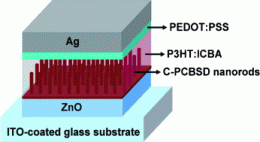Nanorods made of fullerenes improve performance of polymer solar cells

The biggest obstacle to making use of solar energy has been the excessively high price of solar cells made of inorganic semiconductors. In contrast, solar cells based on semiconducting polymers are affordable, light, thin, and flexible -- but their performance has been lacking. A team led by Chain-Shu Hsu at the National Chaio Tung University and Yuh-Lin Wang at Academia Sinica in Taiwan has now developed a new approach that uses fullerene nanorods to significantly increase the effectiveness of polymer-based solar cells. They introduce their work in the journal Angewandte Chemie.
In the photoactive layer of a solar cell, light energy sets electrons free. This leaves behind positively charged gaps or "holes". Electrons and holes must be separated quickly and efficiently, or they recombine and reduce the power of the solar cell. The efficiency of a solar cell thus depends on how well the resulting charge is directed away and transported to the electrodes.
In polymer solar cells, it is possible to attain more efficient charge separation through the addition of acceptors, such as fullerenes, which take up electrons. One highly promising concept is to embed the acceptor molecules in a disordered matrix made of photoactive polymer chains. The boundary surface between the two components is thus spread over the entire layer. This construct is known as a “bulk-hetero contact”. After charge separation, the electrons and holes are located in different molecular systems, which transport them selectively to opposite electrodes.
The problem is that the two materials are not evenly distributed. The travel pathways for the charges are thus disordered, allowing holes and electrons to encounter each other easily. In addition, charge-separated islands can occur. The solution would be an “ordered bulk-hetero contact”, a periodic structure of vertically directed, interpenetrating regions of both materials. Electrons and holes would then have straight pathways that do not cross. However, it has previously not been possible to produce any effective photolayer using this principle, because the components are not molecularly intermixed, making the electron pathways too long to produce effective charge separation.
The Taiwanese researchers decided to combine the two structural principles. By using a nano-casting process, they produced a layer of vertically oriented nanorods from a cross-linking polymeric fullerene material. The spaces between the rods were filled with a mixture made from a photoactive polymer and a fullerene. This layer ensures effective charge separation, and the interpenetration of the fullerene nanorods ensures ordered – and thus effective—charge transport. Solar cells made with this novel combined photolayer are stable and achieve amazingly high performance.
More information: Chain-Shu Hsu, Enhanced Performance and Stability of a Polymer Solar Cell by Incorporation of Vertically Aligned, Cross-Linked Fullerene Nanorods, Angewandte Chemie International Edition, Permalink to the article: dx.doi.org/10.1002/anie.201103782
Provided by Wiley

















